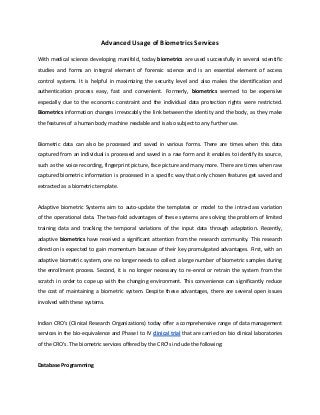
Advanced usage of biometrics services
- 1. Advanced Usage of Biometrics Services With medical science developing manifold, today biometrics are used successfully in several scientific studies and forms an integral element of forensic science and is an essential element of access control systems. It is helpful in maximizing the security level and also makes the identification and authentication process easy, fast and convenient. Formerly, biometrics seemed to be expensive especially due to the economic constraint and the individual data protection rights were restricted. Biometrics information changes irrevocably the link between the identity and the body, as they make the features of a human body machine readable and is also subject to any further use. Biometric data can also be processed and saved in various forms. There are times when this data captured from an individual is processed and saved in a raw form and it enables to identify its source, such as the voice recording, fingerprint picture, face picture and many more. There are times when raw captured biometric information is processed in a specific way that only chosen features get saved and extracted as a biometric template. Adaptive biometric Systems aim to auto-update the templates or model to the intra-class variation of the operational data. The two-fold advantages of these systems are solving the problem of limited training data and tracking the temporal variations of the input data through adaptation. Recently, adaptive biometrics have received a significant attention from the research community. This research direction is expected to gain momentum because of their key promulgated advantages. First, with an adaptive biometric system, one no longer needs to collect a large number of biometric samples during the enrollment process. Second, it is no longer necessary to re-enrol or retrain the system from the scratch in order to cope up with the changing environment. This convenience can significantly reduce the cost of maintaining a biometric system. Despite these advantages, there are several open issues involved with these systems. Indian CRO’s (Clinical Research Organizations) today offer a comprehensive range of data management services in the bio-equivalence and Phase I to IV clinical trial that are carried on bio clinical laboratories of the CRO’s. The biometric services offered by the CRO’s include the following: Database Programming
- 2. ● CRF Design (paper & electronic) ● CRF Annotation ● Database Programming ● Validation Checks ● Metadata Repository Management Data Management ● Data Acquisition ● Data Reconciliation ● Discrepancy Management ● Medical Coding (MeDRA & WHODD) ● Database Lock ● Data Extraction for Reporting Pharmacokinetic & Pharmacodynamic Studies ● Sampling Point Estimation ● Technical Document Review ● PK/PD Query Resolution ● PK/PD Subject Matter Expert ● Pharmacokinetic support across study engagement PK/PD Reporting ● SDMS Data Extraction ● PK Data Analysis ● PK Summary Reporting Biostatistics ● Randomization
- 3. ● Sample size estimation ● Trial Design Inputs ● Statistical Analysis Plan ● Statistical Analysis ● Biostatistics Subject Matter Expert Statistical Reporting ● TLF Programming ● CDISC Data Mapping (SDTM & ADaM) ● Clinical Data Repository ● Pooled Data Analysis & Reporting ● Safety (ADR) Reporting ● Patient Profiles & Data Cleaning Reporting The primary objective of biometric companies is to convert raw data to accurate and reliable trial results that remain compliant with selected regulatory services and policies. In addition to that, these companies have their biometric teams that work in order to accelerate the regulatory submission process and reduce timeline. Read More About: Biometrics Companies, Clinical Pharmacokinetic, Bioavailability
